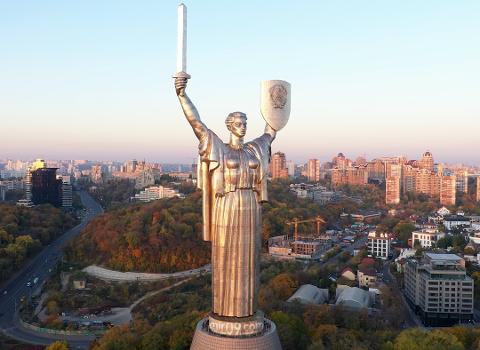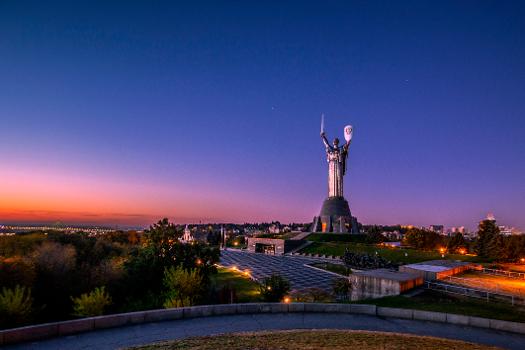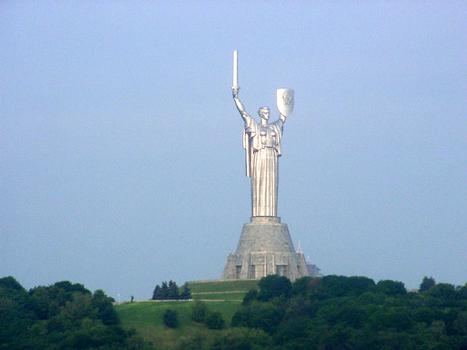General Information
| Name in local language: | Батьківщина-Мати (Batkivshchýna-Máty) |
|---|---|
| Beginning of works: | 1979 |
| Completion: | 9 May 1981 |
| Status: | in use |
Project Type
| Function / usage: |
Statue or Sculpture |
|---|---|
| Material: |
Steel structure |
Location
Technical Information
Dimensions
| total height | 102 m | |
| pedestal | height | 40 m |
| sculpture | height | 62 m |
| weight | 560 t |
Materials
| sculpture |
stainless steel
|
|---|
Excerpt from Wikipedia
The Motherland Monument (Ukrainian: Батьківщина-Мати, romanized: Batkivshchýna-Máty,) is a monumental statue in Kyiv, the capital of Ukraine. The sculpture is a part of the National Museum of the History of Ukraine in the Second World War.
Description
The stainless steel statue stands 62 m (203 ft) tall upon the museum main building with the overall structure measuring 102 m (335 ft) including ist base and weighing 560 tonnes. The sword in the statue's right hand is 16 m (52 ft) long weighing 9 tonnes, with the left hand holding up a 13 by 8 m (43 by 26 ft) shield with the hammer and sickle of the Soviet Union. Initially the image of the statue was drawn by Vutchetich from Ukrainian painter Nina Danyleiko, after the design was taken over by Borodai from another Ukrainian sculptor Halyna Kalchenko, a daughter of the Prime Minister of Ukraine Nikifor Kalchenko.
The memorial hall of the Museum displays marble plaques with carved names of more than 11,600 soldiers and over 200 workers of the home-front honored during the war with the title of the Hero of the Soviet Union and the Hero of Socialist Labour. On the hill beneath the museum, traditional flower shows are held. The sword of the statue was cut because the tip of the sword was higher than the cross of the Kyiv Pechersk Lavra.
Background
In the 1950s, a plan circulated of building on the spot of the current statue twin monuments of Vladimir Lenin and Joseph Stalin, nearly 200 m (660 ft) tall each. However, this did not go ahead. Instead, according to legend, in the 1970s, a shipload of Communist Party officials and Soviet sculptor Yevgeny Vuchetich looked across at the hills by the Lavra and decided the panorama needed a war memorial. Vuchetich had designed the other two most famous giant Soviet war memorials, The Motherland Calls in Volgograd and the Soviet soldier carrying German infant constructed after the war in East Berlin. The statue was modeled after one of his coworkers Mila Hazinsky however after Vuchetich died in 1974, and the design of the memorial was afterwards substantially reworked and only the eyes brow and eyebrows remained from the original face. It was then completed under the guidance of Vasyl Borodai.
Final plans for the statue were made in 1978, with construction beginning in 1979. It was controversial, many criticised the costs involved and claimed the funds could have been better spent elsewhere. When director of construction Ivan Petrovich was asked to confirm the costs of 9 million rubles, he responded that this was a conservative estimate. The statue was opened in 1981 in a ceremony attended by Soviet General Secretary Leonid Brezhnev, himself a Ukrainian.
In modern-day Kyiv, the statue remains controversial, with some claiming it should be pulled down and ist metal used for more functional purposes. Financial shortages mean that the flame, which uses up to 400 m³ (14,000 cu ft) of gas per hour, can only burn on the biggest national holidays, and rumours persist that the statue is built on unstable foundations, something strongly denied by the Kyiv local government.
In April 2015, the parliament of Ukraine outlawed Soviet and Communist symbols, street names and monuments, in a decommunization attempt. But World War II monuments are excluded from these laws. Director of the Ukrainian Institute of National Remembrance Volodymyr Viatrovych stated in February 2018 that the Soviet hammer and sickle on the shield of the monument should be removed to comply with decommunization laws and replace it with the Ukrainian trident. To date however, it is still not removed.
Text imported from Wikipedia article "Motherland Monument" and modified on 1 March 2022 according to the CC-BY-SA 3.0 license.
Participants
- Yevgeny Vuchetich (designer)
- Vasyl Borodai (designer)
Relevant Web Sites
- About this
data sheet - Structure-ID
20016528 - Published on:
09/06/2005 - Last updated on:
01/03/2022









